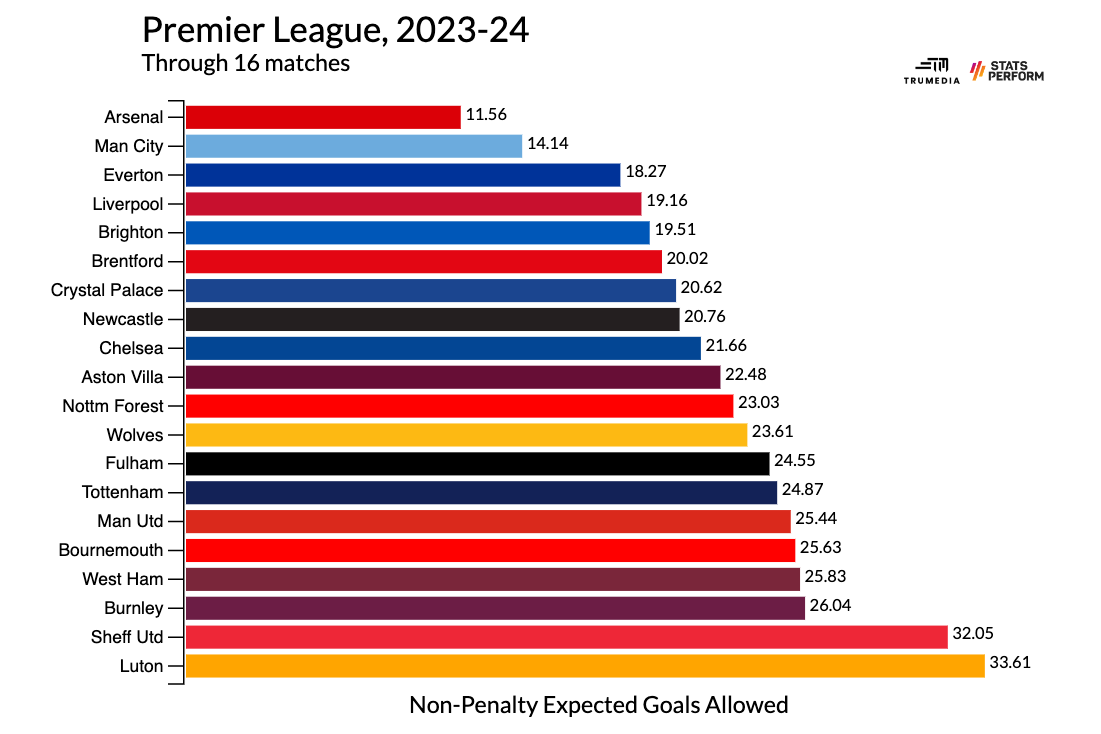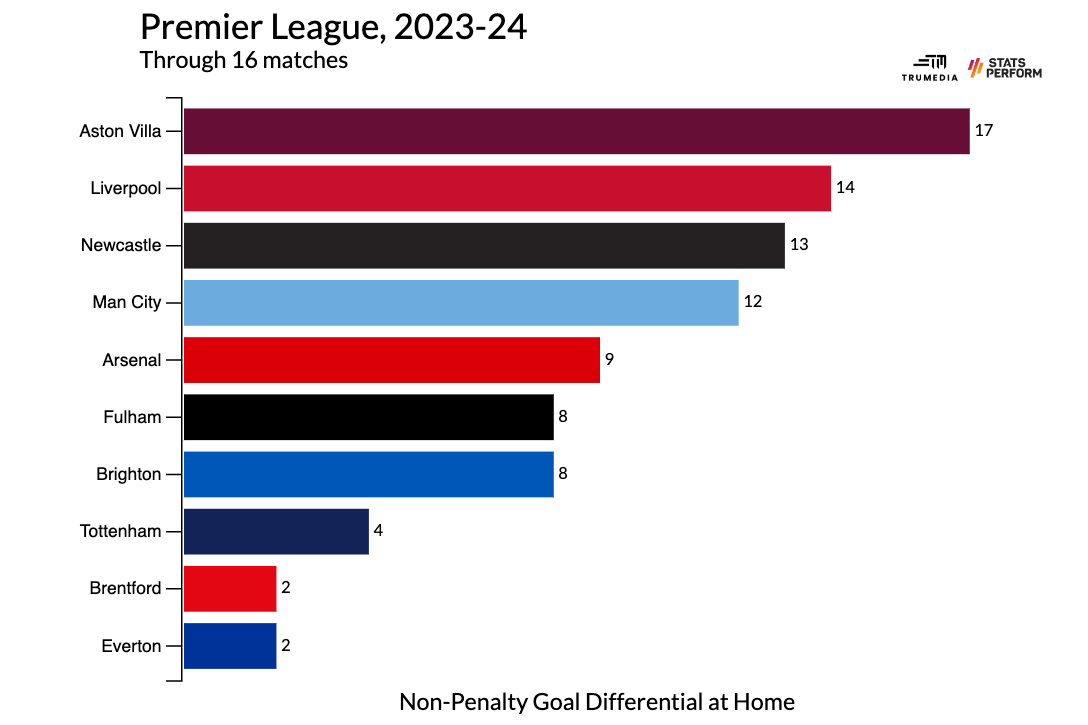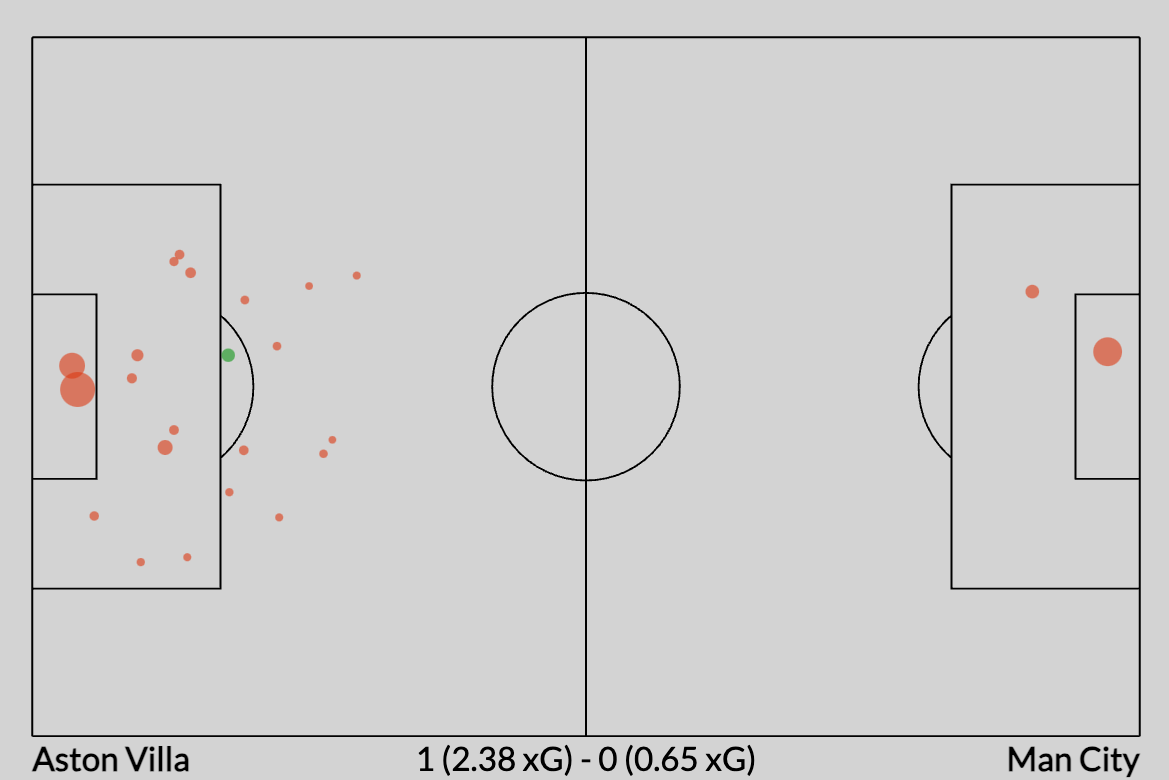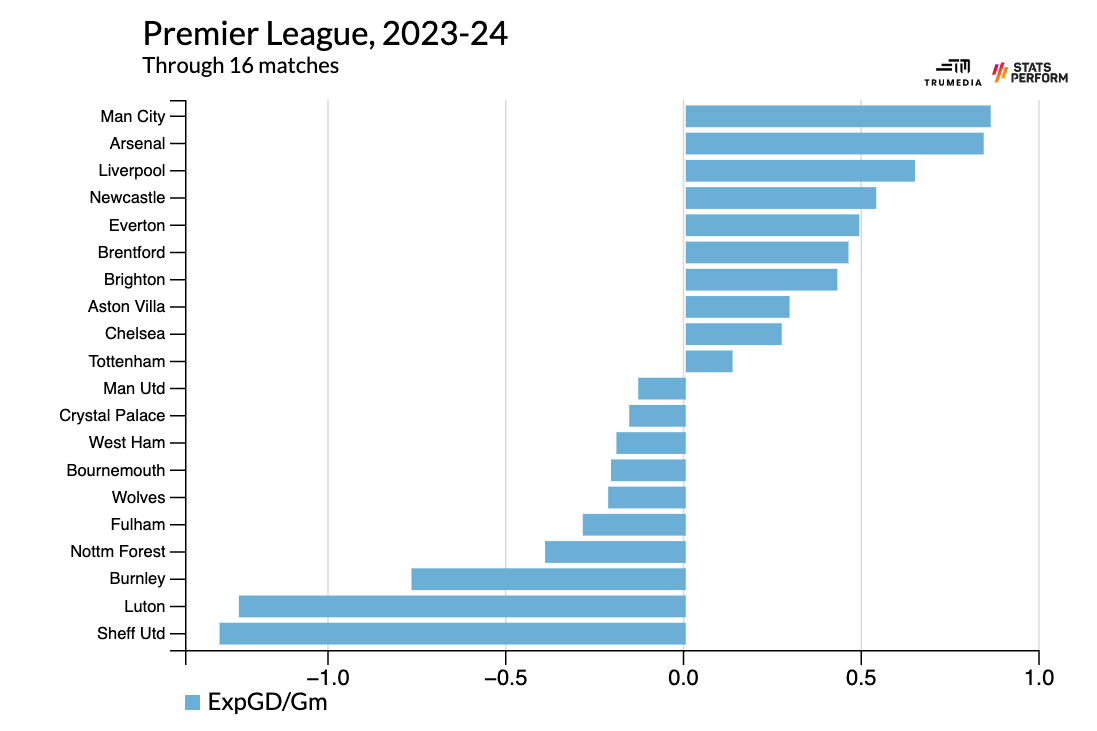We have a title race, people. Nearly halfway through the Premier League season, just four points separate fourth place from first. And perhaps most importantly for the drama of the race itself, the three-time defending champs, Manchester City, are the ones in fourth.
What's that? Yeah, I see you rolling your eyes. And I can tell you're thinking to yourself, Get a life, man. We do this every year, and Manchester City still win every time (except that one time). While we won't get into how I know which parts of your thoughts belong inside of parentheses, I will simply reply with what the betting markets are telling us.
Per Sporting Index, which allows you to place bets on both sides of each team's point-total projection, Manchester City are projected to finish with 84 points, Liverpool with 81 and Arsenal with 80. Before the season, Liverpool were projected to finish 12 points back of City, while Arsenal's projection put them nine points behind. In other words, the expected gap between first and second has already shrunk by two-thirds, and we still have a few games to go before we're even at the halfway point of the season.
Given Aston Villa's, you know, consecutive wins over front-runners Man City and Arsenal, we have to throw the Villans (projected to finish fourth, on 71 points) into the conversation, too.
So let's run through the four Premier League title contenders, in order of their present positions in the table, and sketch out why they all will and won't win the Premier League title.
 1. Liverpool
1. Liverpool
Why they will win: They have the best attack in the league
Behold this chart, which ranks all 20 Premier League teams in order of how many non-penalty expected goals, or xG, they've created thus far:

This, of course, is despite the fact that Liverpool have been given four red cards already this season -- more than any other team in the league. They've managed it because they're good at just about every aspect of creating chances. When you divvy it up, here's where they rank in terms of xG created:
Counterattacks: 3.14, 2nd
Set pieces: 6.05, 2nd
Regular open play: 19.94, 5th
No other team in the league offers that same level of prowess across all the phases of creating chances.
On an individual level, they're the only team in the league with two players in the top 10 for both non-penalty expected goals and expected goals assisted. The same guy -- Mohamed Salah -- is leading the team in both non-penalty xG (7.3, 5th in the league) and xA (6.0, 1st). Meanwhile, Darwin Núñez sits seventh in the league for non-penalty xG (6.6). The Darwin Experience continues apace, with the Uruguayan turning those chances into just four non-penalty goals. This chart below shows his shots -- the bigger the circle, the higher the xG:

Despite a bevy of seemingly impossible misses, Núñez ranks fifth in the league in pure attacking production, as measured by non-penalty goals plus assists per 90 minutes (0.93). The reason Liverpool manager Jurgen Klopp keeps playing Darwin -- and why nerds like me think that he should -- is that even with all the misses, he's still one of the most productive attackers in the league. If he simply just starts converting his chances at a league-average rate? Then ... [head explodes just from thinking about it].
On the creative front, Trent Alexander-Arnold ranks seventh in the league with 4.1 expected assists, or xA, which puts him at a per-90 rate that is right up around his career average. He has maintained that creativity, too, despite a new role that asks him to drift deeper and has led to a significant decline in the number of touches in the attacking third and opposition penalty box. But we already knew he could do that.
He's joined in the top 10 by one of the revelations of the season, Dominik Szoboszlai, who ranks 10th in the league with 4.0 expected assists. In fact, Szoboszlai has already generated more xA than the player he replaced, Jordan Henderson, did in all of last season.
Throw in more creativity from the other new or more prominent midfielders (Alexis Mac Allister, Ryan Gravenberch and Curtis Jones) plus a ton of depth across the rest of the front line (Diogo Jota, Luis Díaz, and Cody Gakpo) and continued excellence in dead-ball situations, and it all adds up to the most potent offensive team in England.
Why Liverpool won't win: Their defense isn't as good as that of other top teams
It's really hard to envision a world where Liverpool win the league and Alisson isn't the best goalkeeper in the world. Luckily for them, Alisson probably is the best goalkeeper in the world.
Let's think of it this way. Liverpool have allowed 19.7 non-penalty expected goals so far this year. That's third best in the league, but it's way below where either Man City or Arsenal currently sit. Were their opponents to convert at a league-average rate, that averages out to about 1.23 goals per game and about 47 goals over a full season.
During the 38-game era of the Premier League, the most goals allowed by a league winner were the 45 conceded by Manchester United in the 1999-2000 season. Second most: 44, also by United in '96-97. Third most: 43 again by United in 2012-13. After that, no other title winner has allowed more than 37. The average is about 32, or 0.84 per game.
Now, along with Arsenal, Liverpool have still allowed the fewest goals in the league so far this season: 15, or 0.94 per game. And almost all of the gap between their xG allowed and goals allowed comes down to Alisson, who has saved 4.0 goals more than expected based on Stats Perform's post-shot xG model.
Given that the team isn't playing with a real defensive midfielder and that both of its full-backs still get forward (unlike almost every other top team these days), Klopp is making the bet that the attacking force his side generates will outweigh the defensive instability caused by these choices.
Now, it's possible that the defense improves, but that seems unlikely with first-choice center back Joël Matip now likely out for the season with a torn ACL. Instead, Liverpool will need Alisson to continue doing everything he can in order to keep them just below that title-winning threshold of goals allowed.
 2. Arsenal
2. Arsenal
Why Arsenal will win: They have the best defense in the league
Behold, the same graph as above, except it's for non-penalty goals conceded:

For Arsenal, that averages out to 0.64 non-penalty xG conceded per 90 minutes -- a significant improvement from last season, when they allowed 0.93 xG per 90. So, what changed?
Mainly: the personnel. William Saliba might be the best center back in the league -- he's easily the one you'd take for any amount of time beyond one or two seasons -- and has played every minute for Arsenal this campaign. Last season, he played 71% of the available minutes, and the team's late-season collapse correlated pretty tightly with him getting injured.
And then there's Declan Rice, who I called a "high-risk signing" over the summer because of the massive fee and the massive style shift in going from West Ham to Arsenal. Well, looks like the Gunners nailed this one. As long as he doesn't get hurt -- and he has a sterling history of availability -- Rice seems like he'll be sitting in the Arsenal midfield for the next half-decade-plus.
Interestingly, much of Rice's statistical output -- both defensively and on the ball -- hasn't shifted a ton despite moving from one of the most devoted-to-the-counter teams in the league to a side that wants each match to have as few possession changes as possible. Maybe team context is a little less important than we think? Or maybe -- definitely -- we still don't have great metrics for accurately representing the impact of midfielders? It's likely a bit of both.
The other reason for Arsenal's defensive improvement comes from manager Mikel Arteta's lineup choices. Rice has frequently played in front of or with the immobile Jorginho, which is a much more conservative midfield setup than we saw last season. And same goes across the back line, where Arteta first looked to hybrid center back Jurriën Timber as a full-back before he got hurt, then did the same with Takehiro Tomiyasu, himself somewhere between a full-back and center back, before he also got hurt. Center back Jakub Kiwior and defensive midfielder Thomas Partey have also been given looks in the full-back role.
There are two simple ways to improve your defense: acquire better defenders or play more defenders. Arsenal have managed to do both.
Why Arsenal won't win: Their attack isn't as good as it used to be
Despite the massively improved defense, through 16 matches Arsenal have the exact same non-penalty xG differential as last season: plus-0.84 per game. That, of course, means that the attack isn't as good as it was a season ago:
2022-23: 1.69 non-penalty xG per game
2023-24: 1.39 non-penalty xG per game
Given how their overall xG differential has remained exactly the same, year over year, it seems right to blame the decline of the attack on the structural tradeoffs being made, either within Arteta's tactics or from the players he's choosing to play. In other words, it doesn't seem likely to me that the defense has improved without hampering the attack.
That said, the biggest effects can be seen in the performances of Gabriel Martinelli and Martin Odegaard. The former is averaging 0.33 non-penalty xG+xA per 90 minutes, which is way below what you'd expect from a starting attacker on a title- and Champions League-contending team. Martinelli is getting on the ball into the penalty area more often this season and he's receiving more progressive passes than last season -- he's also just touching the ball way more often.
But the problem is that Arsenal are playing much slower than last season. They moved the ball upfield at a rate of 1.2 meters per second in the previous season, and that's dropped down to 1.0 meters per second this season. Martinelli is getting on the ball much more often, but Arsenal's measured buildup play means that there are more defenders behind the ball when he gets it. As such, he's attempting shots from the exact same distance from goal as last season (15.4 yards), but the quality of those attempts has dropped by a third, from 0.12 xG per shot to 0.08.
After a breakout season in 2022-23, Odegaard's output has dropped down to where it was in the previous few years at Arsenal. Last season, he gave them top-level attacker production (0.52 non-penalty xG+xA per 90) from midfield, but this season, he's giving them solid attacking production for a midfielder. And almost all of the decline comes in front of goal. He has nearly halved his xG output by taking both fewer shots (2.7 per 90 last season, down to 2.0 this season) and worse shots (0.11 xG per shot, down to 0.06).
The upside case for Arsenal, then, is that Martinelli and Odegaard figure out a way to have the same impact as last season within this much slower, much more deliberate approach. The attack takes a leap, while the defense remains elite. If that doesn't happen, though, the Gunners might need to take down a bunch of grind-it-out 1-0 wins if they're going to win this thing.
 3. Aston Villa
3. Aston Villa
Why Aston Villa will win: They're a title winner at home
Through eight matches, Villa are perfect at Villa Park: eight wins from eight. Across those games, their non-penalty xG differential is plus-0.94. Over a 38-game season, that level of performance would've given them a pretty solid chance at challenging the great Manchester City and Liverpool teams of the past five years atop the table. In fact, in a full season over the past five years, no non-City-or-Liverpool side has even reached the plus-0.9 xG differential mark.
Through 16 matches this season, Villa have the most home points and the best home goal differential in the league, too:

And that's despite already playing Arsenal and Manchester City, last season's top two, at home. While the Arsenal win was characterized by an early goal and then an 80-plus-minute effort to keep the Gunners at arm's length, the City game before it was, uh, total domination?
This is the xG map of the match, which shows all of the non-penalty shots in red and goals in green -- the larger the circle, the higher the expected goals on each chance:

A simpler way to sum that up is the following:
City attempted two total shots -- the fewest of any team managed by Pep Guardiola -- ever.
Villa attempted 22 total shots -- tied for the most ever faced by any team managed by Pep Guardiola.
It's one thing to achieve one of those distinctions in a game, but against City you usually have to make massive sacrifices and tradeoffs to stymie their attack or pummel their back line. Instead, Villa just did both, at the same time, without making any sacrifices. Sure, they ceded some possession, but otherwise they just played the defending treble winners straight up and completely ran them off the field.
Arsenal beat City at home, too, this season, but that was in a match where they barely created anything dangerous and won only because a ball deflected off City defender Nathan Aké's face. Liverpool stole a draw off City at the Etihad -- and, yeah, I used the word "stole" for a reason:

Villa, meanwhile, outplayed City to a degree that we haven't really ever seen before. If they can do that, then why can't they win the league?
Why Aston Villa won't win: They're a relegation fighter on the road
Through their eight road games, Villa have won 11 points and produced a goal differential of minus-5. On the more predictive end of things, they're on a per-game non-penalty xG differential of plus-0.39.
The closest team to that mark over the full 16-game slate this year is Nottingham Forest. They're in 16th place, just five points clear of the relegation zone.
Now, chopping up performance into splits often just serves to confuse rather than clarify. You're almost always better off looking at the aggregate of play when trying to ascertain a team's true performance level. The smaller the sample you snip the stats into, the more randomness you're introducing into the results.
That said, this gap in performance is quite stark. Home-field advantage this season is worth 0.3 non-penalty goals per game, so we'd expect the perfectly league-average team to have something like a plus-6 goal difference at home and a minus-6 goal difference on the road over the course of a season. Villa are at plus-17 at home, and minus-5 on the road -- less than halfway through the season.
I think some of that does come from the deliberate approaches that Aston Villa manager Unai Emery typically takes with his teams, depending on the opponent and depending on the location. Over his career across the Big Five leagues, Emery's teams outscore their opponents by 1.1 non-penalty goals per game at home and 0.2 non-penalty goals on the road. That seems like a bigger discrepancy than simple home-field advantage would explain.
Ultimately, though, it doesn't really matter, since all of the games count the same. Here's where Villa stand by per-game non-penalty xG differential, compared to the rest of the league:

They're at plus-0.29 through 16 matches. That probably won't be enough to get it done. Villa have the exact same number of points as Leicester did at this stage of the 2015-16 season, but the Foxes were operating at a reasonably higher underlying performance level (plus-0.45). Plus, Leicester didn't have to compete with a team at the level of this year's Liverpool, Arsenal or City -- let alone all three.
 4. Manchester City
4. Manchester City
Why Man City will win: They're the best team
Another way to understand those Sporting Index projections I mentioned in the intro is by flipping them inside-out and seeing which teams are expected to win the most points over the remainder of the season. Yes, the schedules are a little lopsided, so this isn't a pure ranking of "the best teams according to people who make money by knowing who the best teams are," but it's close.
Here's the top six, in order of projected rest-of-season points:
1. Manchester City: 51
T-2. Liverpool and Arsenal: 44
4. Chelsea: 40
5. Newcastle: 39
T-6. Aston Villa and Tottenham: 36
If we converted that to a 38-game season, here's how the standings would end up:
1. Manchester City: 88
T-2. Liverpool and Arsenal: 76
4. Chelsea: 69
5. Newcastle: 67
T-6. Aston Villa and Tottenham: 62
Ignoring the three teams we're not talking about today, those totals suggest that, given their underlying quality, City have hit close to the bottom range for potential points from the first 16 games, while Liverpool, Arsenal and Villa have come close to maxing out their point totals.
There's also the small matter of City playing the first half of this season without maybe the best player in the league. Since 2021, there is one player in Europe's Big Five leagues who has started at least 50 games and hit the following per-90 benchmarks: 0.5 non-penalty xG+xA, 7 progressive passes, 3 progressive carries, and 8 progressive carries. It's Kevin De Bruyne. The only other Champions League players who have hit those same benchmarks (except for the number of starts) are Neymar and Ousmane Dembélé. The big difference, of course, is that De Bruyne is a midfielder.
Now, De Bruyne is 32, so there's no guarantee he comes back for the second half of the season as the KDB of old after his hamstring injury. But imagine if Liverpool didn't have Salah or Arsenal didn't have Bukayo Saka for the first 16 games of the season. Would either team be in title contention right now? City still are and they still produced the best xG differential in the league without perhaps the most impactful player in the league. That speaks to a durability to injuries that these other three teams don't really have.
Why Man City won't win: It's not just one team chasing them anymore
The best team often doesn't win the league. There's no real way to confidently define best, but what if we just look at the non-penalty expected goal differential of every team to win a Big Five league title since 2018?
In Serie A, Inter Milan have had the best non-penalty xG differential in the league in each of the past three seasons but only one title to show for it. Before that, Atalanta led the league in consecutive years and finished third both times, while Napoli did the same in 2017-18 and finished second. That's just one out of six best-team titles.
In France, Paris Saint-Germain have won the league in five of six seasons -- all with the best underlying numbers in Ligue 1. The year that Lille won, they ranked fourth by xG differential, while Lyon -- not PSG -- ranked first. So, that's five of six best-team titles.
In Spain, Barcelona have had the best xG differential in the league in all of the previous six seasons, but they've won the league in only half of those campaigns. In Germany, Bayern have converted six dominant seasons into six titles. And in England, City have had the best xG differential in all six seasons; they've won five titles -- Liverpool won in 2019-20 -- but two of them were by just one-point margins.
Add all of those seasons together, and the "best" team has won 21 of the past 30 league titles -- or about 70% of the domestic-league trophies across the Big Five. This isn't how math works, but, were a team without the best underlying numbers to win the Premier League this season, it would be right in line with that rate: two "upset" winners from seven years.
On top of that, the degree to which City are the "best" team has shrunk, at least to start the season. Over a full campaign with Guardiola in charge, they've never had a per-game non-penalty xG differential below plus-1, and they're currently at plus-0.86. They've been worse through 16 games a few times, though -- one season (2019-20) they still easily won the league, and in the other (2016-17) they finished third.
City, then, are as vulnerable as they've ever been. In the past, Liverpool and Arsenal had to be perfect, because they were chasing a perfect team. Liverpool frequently were perfect, and it still didn't matter, while last season Arsenal seemed to buckle under the pressure. This time, though, they're both right there. That increases the likelihood that one of them just stays hot, gets some lucky bounces and keeps City at arm's length for the rest of the season. It also increases the chances that one of them maintains a true jump in performance level for the last 22 games and matches or even exceeds City's level of play, all from a higher-up platform of current points.
Throw in Aston Villa, who still do have an outside shot of shooting the moon, and it really seems like -- as suggested by Opta's projections -- we've reached a point that we haven't seen in the Premier League too often. Manchester City are the favorites to win the Premier League, but the most likely outcome to the season is that a team other than City ends up lifting the trophy.
